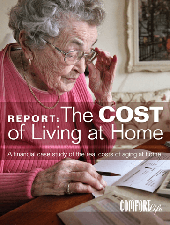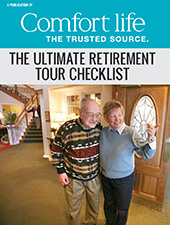So, in a final review of aging at home, have Graham and Ethel “spent smart” to make the most of their money?
- In Scenario I (using community support), the couple was partially in denial of their health and lifestyle needs. They made minimal changes to their lifestyle, although accepting Meals on Wheels probably made the largest contribution to their health, making it very easy for them to eat healthy, balanced meals. It also opened the door to their accepting outside help.
- In Scenario II, hiring their permanent part-time personal support worker Cora was undoubtedly costly and making up the shortfall did deplete Graham’s savings. However, it allowed the couple to stay in their home, use their car and keep up the semblance of their usual life, in a reasonably ideal instance of aging in place. This was an important phase in their transition to accepting help in their own “space,” especially for Ethel. When Ethel’s health and Graham’s dementia meant more hours of Cora’s support were needed, it would have been impossible to fund. In fact, their sons were planning to review the situation with them when Ethel was admitted to hospital with breathing problems.
- In Scenario III, having a live-in caregiver seemed financially affordable but would have required the services of a care manager to supervise and direct the care; a family cannot simply hand a caregiver the house keys and hope for the best! A care manager would ensure that medication was taken and medical appointments were made and followed up on, and she would also monitor changes in health conditions and direct the caregiver in implementing treatment plans. A typical care manager would charge $125 per hour and be needed at least one hour per week in this aging at home scenario.
- In Scenario IV, moving to a local retirement community, although Graham and Ethel are paying more per month than in any of the previous scenarios, they are saving on many expenses that are no longer required. They will also be able to acquire more care—at $25 per hour, in 15-minute increments - when they need it in a shared-care arrangement offered by the retirement residence, rather than having to hire someone privately.
Aging in place is a wonderful idea, but if it is to be an effective, safe alternative, it is not free. And it is often more costly than what you would pay in a retirement community.
The key is for family members to discuss plans for retirement or long-term care well ahead of time. Having a practical and caring discussion early on is much better for everyone than having to make decisions in a hurry after a health crisis. As always, knowledge is power, so gather your information now to face the challenges of this wonderful chapter of life with confidence and success.




